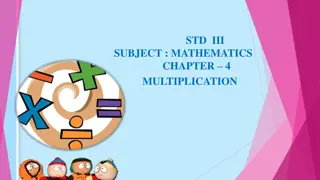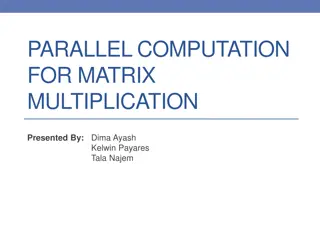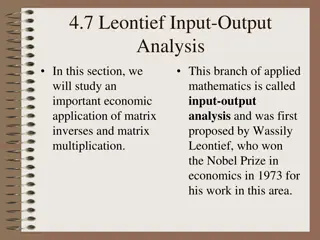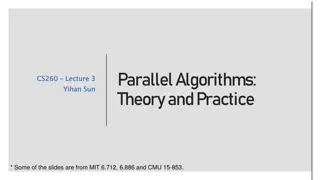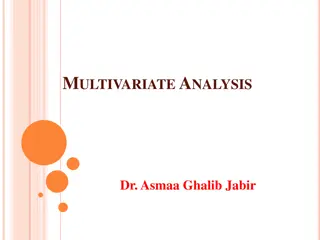
Understanding Matrix Multiplication: Rules and Examples
Learn how to multiply matrices step-by-step, including the rules and properties of matrix multiplication. Understand the dimensions of the answer, calculation methods, and practice examples for better comprehension.
Download Presentation

Please find below an Image/Link to download the presentation.
The content on the website is provided AS IS for your information and personal use only. It may not be sold, licensed, or shared on other websites without obtaining consent from the author. If you encounter any issues during the download, it is possible that the publisher has removed the file from their server.
You are allowed to download the files provided on this website for personal or commercial use, subject to the condition that they are used lawfully. All files are the property of their respective owners.
The content on the website is provided AS IS for your information and personal use only. It may not be sold, licensed, or shared on other websites without obtaining consent from the author.
E N D
Presentation Transcript
Teachings for Teachings for Exercise 6B Exercise 6B
Matrices You need to know how to multiply matrices together These numbers will give the dimensions of the answer The rule for multiplying matrices is what gives them their most useful properties This rule is quite unnatural at first and you should show large amounts of workings, even when you feel you have fully understood the method ? ? = ? ? ? ? ? ? ? You multiply each row in the first matrix, by each column in the second matrix These numbers must be the same for the multiplication to be possible The product will have the same number of rows as the first matrix, and the same number of columns as the second 6B
Matrices 1 3 2 4 3 2 You need to know how to multiply matrices together = The rule for multiplying matrices is what gives them their most useful properties To multiply matrices you first multiply corresponding elements of the rows and columns, then add them up (you ll get it with practice!) 1 3 + ( 2 2) Calculate the value of AB when: 3 3 + (4 2) ? =1 2 4 ? = 3 3 2 3 + ( 4) Then once you have done all the columns, do the same thing, but using the second row (2 x 2) x (2 x 1) (2 x 1) = 9 + (8) These are the same so the multiplication will work = 7 After this, work out each part, and you then have the final matrix answer! 1 These are the dimensions of the answer 6B
Matrices Calculating AB You need to know how to multiply matrices together 1 2 0 3 4 0 1 = 2 The rule for multiplying matrices is what gives them their most useful properties Multiply the first row by each column as in the previous example 1 4 + (0 0) 1 1 + (0 2) Given that: 0 3 2 1 + (3 2) 2 4 + (3 0) ? = 1 ? =4 1 You always fill in the top row of the answer first 2 0 2 4 + (0) 1 + (0) (2 x 2) x (2 x 2) (2 x 2) = 8 + (0) 2 + ( 6) A quick check you have probably done this correctly if the highlighted (green) numbers are the same! Calculate the value of AB and BA ?? = 4 1 4 8 6B
Matrices Calculating BA You need to know how to multiply matrices together 4 0 1 1 2 0 3 = 2 The rule for multiplying matrices is what gives them their most useful properties Multiply the first row by each column as in the previous example 4 0 + (1 3) 4 1 + (1 2) Given that: 0 3 0 0 + ( 2 3) 0 1 + ( 2 2) ? = 1 ? =4 1 You always fill in the top row of the answer first 2 0 2 4 + (2) 0 + (3) 0 + ( 6) 0 + ( 4) A quick check you have probably done this correctly if the highlighted (green) numbers are the same! Calculate the value of AB and BA ?? = 2 3 4 6 BA will be 2 x 2 as well! ?? = 4 1 4 8 Multiplication using matrices is NOT commutative This means the order of multiplication does matter as a different order gives different answers! 6B
Matrices Calculating AB You need to know how to multiply matrices together ? = 3 ? = 1 2 1 2 (1 x 3) x (1 x 2) The rule for multiplying matrices is what gives them their most useful properties As the central numbers are not equal, these matrices cannot be combined Given that: The row in the first has 3 terms, and the columns in the second have 1 term, so the number of terms to multiply will not match up ? = 1 ? = 3 2 1 2 ? =4 5 Determine whether each of the following can be evaluated and if so, find the product: a) AB b) BC c) CA d) BCA 6B
Matrices Calculating BC ? = 3 You need to know how to multiply matrices together ? =4 2 5 (1 x 2) x = (2 x 1) (1 x 1) The rule for multiplying matrices is what gives them their most useful properties Multiply the first row by each column as in the previous example 4 5 = 3 2 Given that: ? = 1 ? = 3 2 1 2 ? =4 3 4 + ( 2 5) This one is unusual as there is only 1 row to multiply by one column, so the final matrix is just one number! 5 12 + ( 10) Determine whether each of the following can be evaluated and if so, find the product: ?? = 2 ?? = 2 b) BC 6B
Matrices Calculating CA ? =4 5 You need to know how to multiply matrices together ? = 1 1 2 = The rule for multiplying matrices is what gives them their most useful properties (2 x 1) x (1 x 3) (2 x 3) Multiply the first row by each column as in the previous example 4 5 Given that: 2 = 1 1 ? = 1 ? = 3 2 1 2 ? =4 (4 1) (4 1) (4 2) Each row has only one number to multiply by the single number in each column! 5 (5 1) (5 1) (5 2) Determine whether each of the following can be evaluated and if so, find the product: 4 4 5 8 ?? = 5 10 ?? = 2 c) CA 8 10 4 4 5 ?? = 5 6B
Matrices Calculating BCA This can be done in one of two ways 1) (BC)A Multiply B by C, and the answer to that by A (in that order) You need to know how to multiply matrices together The rule for multiplying matrices is what gives them their most useful properties 2) B(CA) Multiply C by A, and multiply B by the answer to that (in that order) Given that: ? = 1 ? = 3 2 1 2 ? =4 5 Remember you cannot change the order, so for method 2, do not do CA and then x B after, the B must go at the front! Determine whether each of the following can be evaluated and if so, find the product: ?? = 2 d) BCA 8 10 4 4 5 ?? = 5 6B
Matrices Calculating BCA This can be done in one of two ways 1) (BC)A You need to know how to multiply matrices together The rule for multiplying matrices is what gives them their most useful properties ?? = 2 (1 x 1) ? = 1 (1 x 3) 1 2 = x (1 x 3) Given that: 2 1 2 = 1 ? = 1 ? = 3 2 1 2 ? =4 This one is easy to work out! ??? = 2 2 4 5 Determine whether each of the following can be evaluated and if so, find the product: ?? = 2 d) BCA 8 10 4 4 5 ?? = 5 6B ??? = 2 2 4
Matrices Calculating BCA This can be done in one of two ways 2) B(CA) You need to know how to multiply matrices together 4 4 5 = 8 The rule for multiplying matrices is what gives them their most useful properties ?? = ? = 3 2 5 10 (1 x 3) (1 x 2) x (2 x 3) Given that: ? = 1 ? = 3 2 1 2 ? =4 4 4 5 8 = 3 2 5 10 5 3 4 + ( 2 5) 3 4 + ( 2 5) 3 8 + ( 2 10) Determine whether each of the following can be evaluated and if so, find the product: 12 + ( 10) 12 + (10) 24 + ( 20) ?? = 2 d) BCA 8 10 ??? = 2 2 4 4 4 5 ?? = 5 Same answer! 6B ??? = 2 2 4
Matrices ? = 1 You need to know how to multiply matrices together ? = ? 2 ? (1 x 2) x (2 x 1) = (1 x 1) ? = 1 ? = ? 2 ? 1 ? = ? 2 Given that BA = (0), calculate AB in terms of a. ? 1 + 2 ? First we should calculate BA ?? = ? + 2? ?? = ? + 2? 2? = ? As BA = 0, the implication is that b + 2a = 0 ? + 2? = 0 2? = ? 4C 6B
Matrices ? = 1 You need to know how to multiply matrices together ? = ? 2 ? (2 x 1) x (1 x 2) = (2 x 2) ? = 1 ? = ? 2 ? 1 ? 2 = ? Given that BA = (0), calculate AB in terms of a. 1 ? 1 2 First we should calculate BA ? ? ? 2 ?? = ? + 2? 2? = ? ?? = ? 2 2? We know from before that 2a = b so we can replace the b terms ?? Now calculate AB ?? = 2? 2 2? 2?2 6B
Matrices Why do we multiply matrices like this? Mathematicians realised that for more complicated equations, they needed a more efficient method ? = 3? + 7? Here we have two pairs of equations ? = 3? + 7? ? = 2? + 11? ? = 2? + 11? They wrote the sets of equations as matrices and multiplied them using the method you have seen! Write p and q in terms of x and y ? = 13? 20? ? = 13? 20? ? = 2? + 6? Substitute the first equations into the second ? = 2? + 6? 3 7 11 13 2 20 6 Replace the u terms and the v terms 2 ? = 13(3? + 7?) 20( 2? + 11?) 13 3 + ( 20 2) 13 7 + ( 20 11) ? = 2(3? + 7?) + 6( 2? + 11?) 2 3 + (6 2) 2 7 + (6 11) Multiply out and simplify =79 129 80 ? = 79? 129? 6 ? = 6? + 80? This method then stuck and is the way matrix multiplication has been defined ever since! 6B

